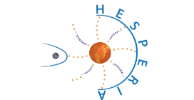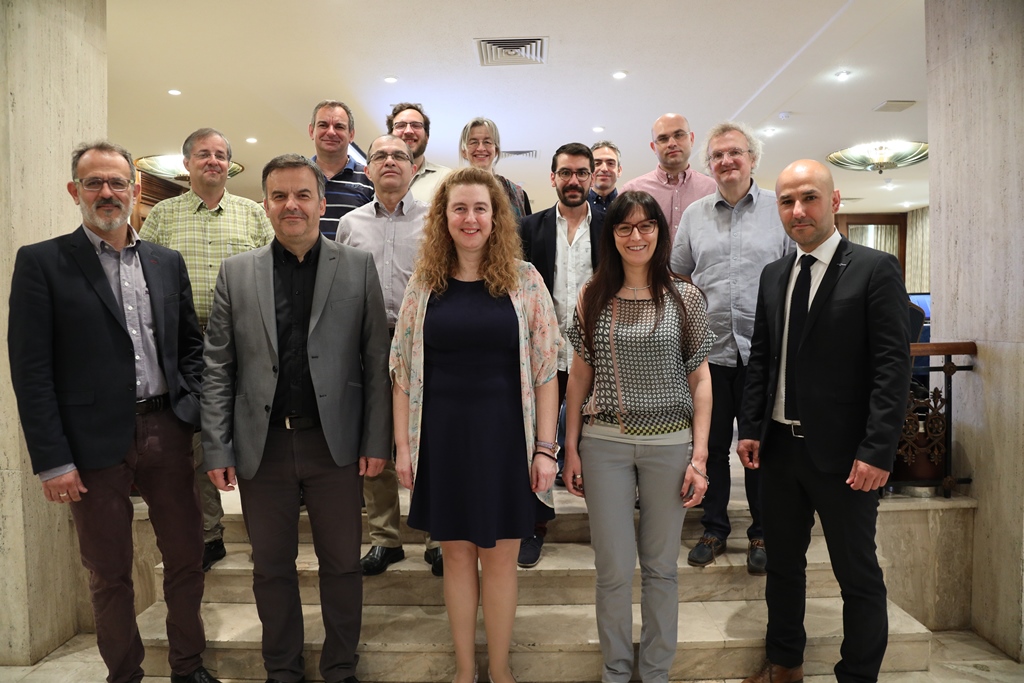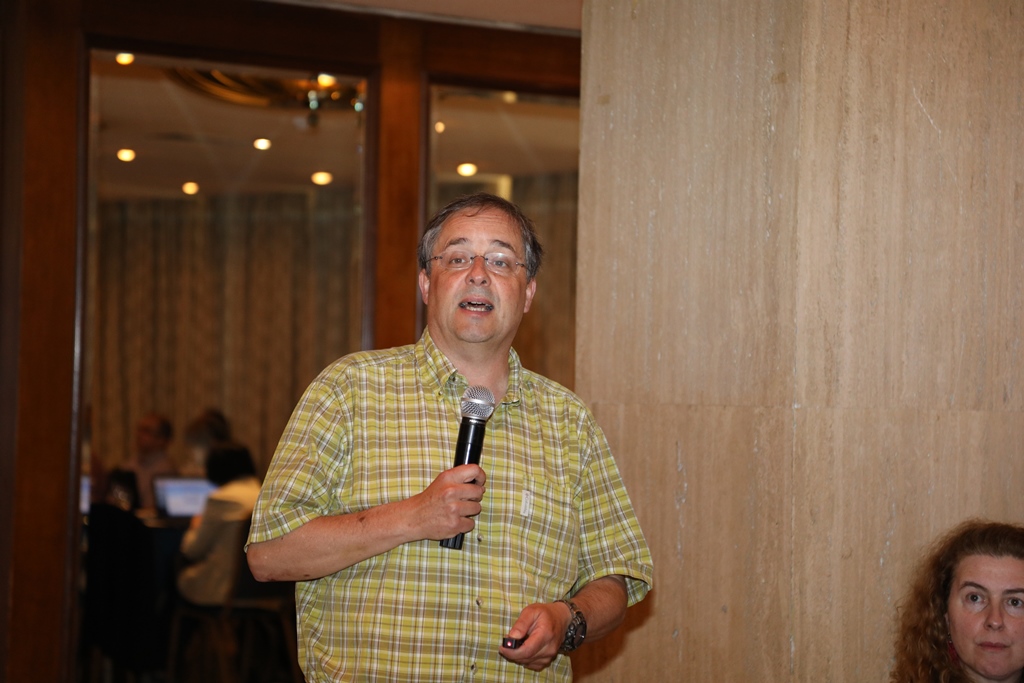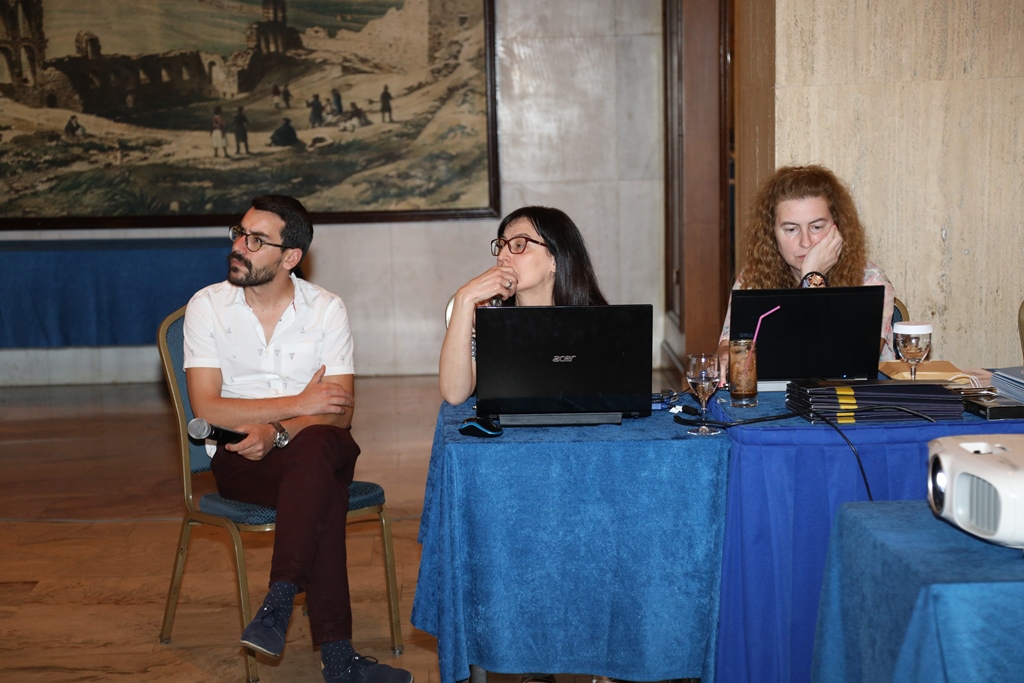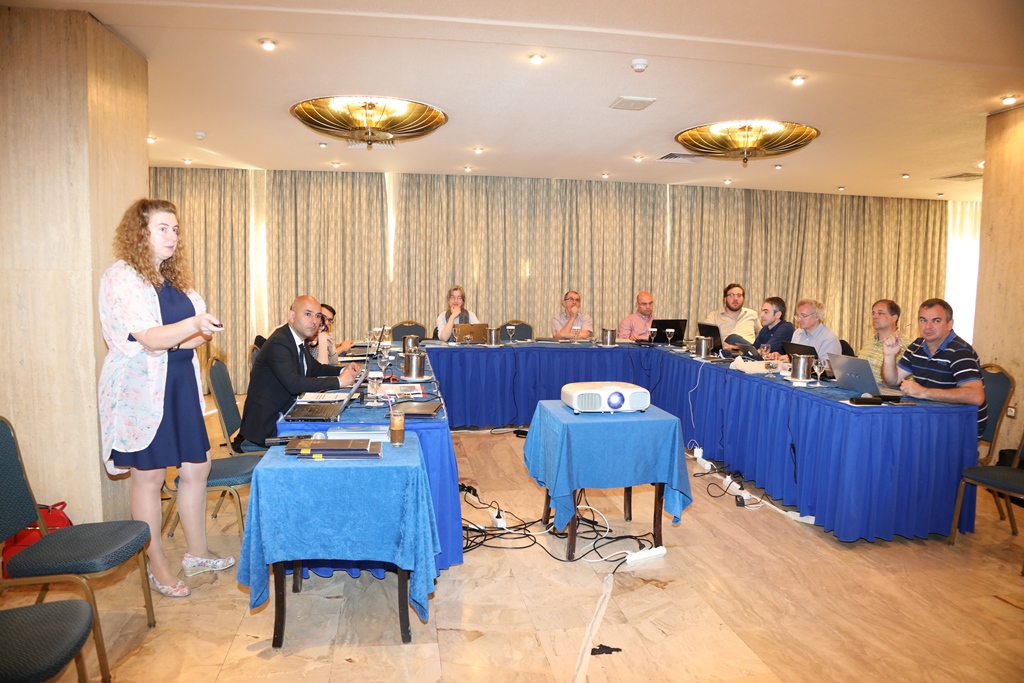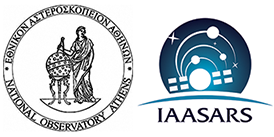| a/a | Name | Institute |
| 1 | Olga Malandraki | NOA |
| 2 | Sabri Mekaui | European Commission / REA |
| 3 | Kanaris Tsiganos | NOA |
| 4 | Georgia Tsiropoula | NOA |
| 5 | Gerry Share | NOA |
| 6 | Vangelis Argoudelis | NOA |
| 7 | Eleni Christia | NOA |
| 8 | Nikos Milas | NOA |
| 9 | Karl Ludwig Klein | OBSPARIS |
| 10 | Mathieu Jacques | OBSPARIS |
| 11 | Rami Vainio | UTU |
| 12 | Neus Agueda | UB |
| 13 | Marlon Nunez | UM |
| 14 | Konstantin Herbst | CAU |
| 15 | Rolf Butikofer | UBERN |
| 16 | Athanasios Papaioannou | ISNet |
| 17 | Christos Sarlanis | ISNet |
| 18 | Norma Crosby | IASB - BIRA |
| 19 | Mark Dierckxsens | IASB - BIRA |
| 20 | Allan Tylka | External Collaborator USA |
HESPERIA Final Review Meeting was organized and hosted by the National Observatory of Athens and took place in Athens, at Divani Palace Acropolis on 23 May 2017 and a dry run, rehearsal day was organized on 22 May 2017.
The Project Officer Dr. Sabri Mekaoui, EU Supervisor Officer for HESPERIA, and Dr. Monica Laurenza, the HESPERIA Reviewer, participated to the meeting as well as to the HESPERIA Consortium. During the meeting, all Work Package (WP) Leaders presented the progress of the work in each WP, according to the Description of Action (DoA) in the Grant Agreement No 637324.
Intensely discussed issues were the project impact and the dissemination and exploitation results of the overall HESPERIA project.
Introduction of HESPERIA UMASEP 500
Solar energetic particles (SEPs) are sometimes energetic enough and the flux is high enough to cause air showers in the stratosphere and in the troposphere, which are an important ionization source in the atmosphere. >500 MeV solar protons are so energetic that they usually have effects on the ground, producing what is called a Ground Level Event (GLE).
One to the goals of the HESPERIA project is the development of a predictor of >500 SEP proton events at the near-earth (e.g. at geostationary orbit). In order to predict these events, the UMASEP scheme [Núñez, 2011, 2015] will be used. HESPERIA UMASEP makes a lag-correlation of solar electromagnetic (EM) flux with the particle flux at near-earth. If the correlation is high, the model infers that there is a magnetic connection through which particles are arriving. If, additionally, the intensity of the flux of the associated solar event is also high, then the HESPERIA UMASEP scheme issues a SEP prediction.
In the case of the prediction of >500 MeV SEP events, the implemented system, called HESPERIA UMASEP-500, correlates X-ray flux with each of the differential proton fluxes measured by the GOES satellites, and with each of the neutron density fluxes collected by neutron monitor stations around the world. When the correlation estimation surpasses a threshold, and the associated flare is greater than a specific X-ray peak flux, a >500 MeV SEP forecast is issued.
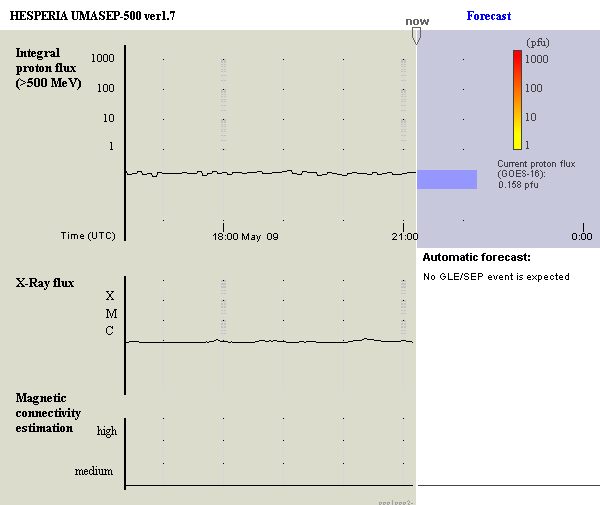
Description of plot
This figure shows the output image of the >500 MeV SEP predictor. This image presents three time series:
• The upper time series of this image shows the recent and the predicted >500 MeV proton flux. The current flux is at the left of the label "Now". The predicted >500 MeV flux is presented at the right of this label. The predicted intensity of the first 1 hour of the expected event are indicated by colors, which corresponds to certain intensity levels (in pfu) according to the vertical bar at the right.
• The middle time series in the left image of the forecast output shows recent solar activity in terms of soft X-rays.
• The time series at the bottom of the forecast output presents the empirically-estimated level of magnetic connectivity of the observed >500 MeV solar particles to Earth.
Validation
Regarding the prediction of >500 MeV SEP event, the forecast performance results of this tool for the period 1986-2016 may be summarized as follows: the POD was 50% (13/26), the FAR was 31.6% (6/19), and the AWT to the first NM's alert was 13 min.
Regarding the prediction of GLE events, the forecasting results for the most recent half of the evaluation period (i.e. 2000-2016) may be used to compare UMASEP-500 with those of the GLE Alert Plus. These results may be summarized as follows: the POD was 53.8% (7 of 13 GLE events); the FAR was 30.0% (3.10); the AWT to the first NM's alert was 8 min; and, the AWT to the GLE Alert Plus's warning was 15 min. The GLE forecasting results for the first half of the evaluation period (i.e. 1986-1999( are summarized as follows: the POD was 31.6% (6 of 19 GLE events); the FAR was 33.3% (3/9); and, the AWT to the first NM's alert was 13.3 min. There are no forecasting results of the GLE Alert Plus for this period.
For the whole evaluation period, the GLE forecasting performance may be summarized as follows: the POD was 40.6% (13 of 32); the FAR was 31.6% (6 of 19); and, the AWT to the first NM's alert was 10.5 min. Note that the FAR of the most recent period is similar to that of the oldest period (30.0% vs. 33.3%); however, the POD of the most recent period (i.e. 53.8%) is better than the POD of the oldest period (i.e. 31.6%). We do not know the reason for the better POD performance in the most recent period; nevertheless, we think that the use of a more recent and refined instrument technology and/or more experienced calibration procedures yields better forecasting performance.
Introduction HESPERIA REleASE:
A major impact on human and robotic space exploration activities is the sudden and prompt occurrence of solar energetic ion events. The fact that near relativistic electrons (1 MeV electrons have 95% of the speed of light) travel faster than ions (30 MeV protons have 25% of the speed of light) and are always present in Solar Energetic Particle (SEP) events can be used to forecast the arrival of protons from SEP events with real-time measurements of near relativistic electrons. The faster electrons arrive at L1 30 to 90 minutes before the slower protons. The Relativistic Electron Alert System for Exploration (REleASE) forecasting scheme uses this effect to predict the proton flux by utilizing the actual electron flux and the increase of the electron flux in the last 60 minutes. A detailed description of the REleASE scheme can be found in Posner et al. (2007). The original REleASE code uses real-time electron flux measurements from the Electron Proton Helium Instrument (EPHIN) onboard the Solar Heliosperic Observatory (SOHO) to make forecasts of the the expected proton flux. This REleASE version provides SEP forecasting since 2008. The results can be found at http://costep2.nascom.nasa.gov
In the framework of the HESPERIA project, a clone of the REleASE system was built in the open source programming language PYTHON. The same forecasting principle with use of the same forecasting matrices were in addition adapted to real-time electron flux measurements from the Electron, Proton & Alpha Monitor (EPAM) onboard the Advanced Composition Explorer (ACE). It is shown, that the REleASE forecasting scheme can be adapted to work with any near relativistic electron flux measurements. The two resulting forecasts, one based on SOHO/EPHIN and one based on ACE/EPAM electron data, are shown below.
Posner, A., Up to 1-hour forecasting of radiation hazards from solar energetic ion events with relativistic electrons, Space Weather, Vol. 5, S05001, doi:10.1029/2006SW000268, 2007.
Description of plot:
The upper panel on both sides shows real-time proton fluxes measured by SOHO/EPHIN. The proton flux in the energy range of 15.8 to 39.8 MeV is shown in red and the proton flux in the energy range of 28.2 to 50.1 MeV is shown in green. The next three panels show the proton flux forecasts obtained with the HESPERIA RELEASE forecasting scheme. From top to bottom the panels show expected proton fluxes in 30, 60 and 90 minutes. On the left and right side the forecasts are based on electron measurements by SOHO/EPHIN and ACE/EPAM, respectively. All forecasts use the same color code as the real-time proton flux in the top panel. The bottom panels on both sides show the measured real-time electron fluxes used for the forecasts. The SOHO/EPHIN and ACE/EPAM electron fluxes cover the energy range of 0.25 to 1.0 MeV and 0.175 to 0.315 MeV, respectively.
Historic Data :
Historic data for HESPERIA REleASE can be found from Data Retrieval Tool.
The HESPERIA REleASE notification system
The HESPERIA Relativistic Electron Alert System for Exploration (HESPERIA REleASE) makes use of relativistic electrons (v > 0.9 c) provided by the Electron Proton Helium Instrument (EPHIN) on SOHO and near-relativistic (v <0.8 c) electron measurements from the Electron Proton Alpha Monitor (EPAM) aboard the Advanced Composition Explorer (ACE), providing deterministic forecasts of the expected proton flux at two energy ranges: 15.8-39.8 MeV and 28.2-50.1 MeV.
In order to illustrate in real-time and in a user-friendly mode the expected radiation impact, as this is forecasted by REleASE, three discrete levels were chosen. In particular:
─ Quiet l Green color
─ Warning l Orange color
─ Alert l Red Color
As a result, a gauge that incorporates all three stages in real-time mode has been implemented. The needle indicates the expected radiation impact, according to the above labeling.
The HESPERIA REleASE Alert System can generate alerts which are distributed to registered users. You can register here.
Validation
Historic (not real-time) data of SOHO/EPHIN and ACE/EPAM from 2009 to 2016 were used to find a good forecast condition for SEP event and to quantify the event-oriented validation metrics (POD, FAR and warning time). We tested different combination of forecasts for different time offsets and found that the following condition delivered the best performance of the forecast systems:
- Alarm: if any forecast >10-1 (cm2 sec sr MeV)-1 and one 30 minute forecast >10-2 (cm2 sec sr MeV)-1.
- Event: if real proton flux >10-1 (cm2 sec sr MeV)-1.
Table 1. Results of REleASE implementation utilizing either SOHO/EPHIN or ACE/EPAM.
| True | Missed | False | POD % | FAR % | Average warning time / min | |
| EPHIN | 24 | 14 | 10 | 63 | 29 | 107 |
| EPAM | 24 | 14 | 13 | 63 | 35 | 123 |

 hesperia [dot] info [at] hesperia-space [dot] eu
hesperia [dot] info [at] hesperia-space [dot] eu